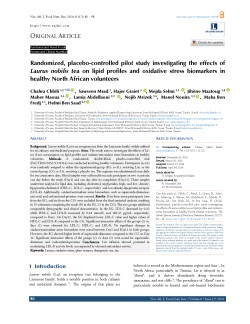Main Article Content
Randomized, placebo-controlled pilot study investigating the effects of Laurus nobilis tea on lipid profiles and oxidative stress biomarkers in healthy North African volunteers
Abstract
Background. Laurus-nobilis (Ln) is an evergreen tree from the Lauraceae family, widely utilized for its culinary and medicinal purposes.
Aims. This study aims to investigate the effects of Ln-tea (Lnt) consumption on lipid profiles and oxidant/antioxidant stress biomarkers in healthy volunteers.
Methods. A randomized, double-blind, placebo-controlled trial (PACTR202205671550114) was conducted involving healthy volunteers. Participants (n=62) were randomly assigned to either the experimental-group (EG, n=31), receiving Lnt, or the control-group (CG, n=31), receiving a placebo tea. The regimen was administered once daily for ten consecutive days. Blood samples were collected from each participant on two occasions: one day before the study (Day1) and one day after its completion (Day11). These samples underwent analysis for lipid data, including cholesterol, triglycerides, high- and low- density-lipoprotein-cholesterol (HDL-C, LDL-C, respectively), and low-density-lipoprotein-receptor (LDL-R). Additionally, oxidant/antioxidant stress biomarkers, such as superoxide-dismutase, uric-acid, and carbonylated-proteins, were assessed.
Results. Data from seven participants (one from the EG, and six from the CG) were excluded from the final statistical analysis, resulting in 55 volunteers completing the study (30 in the EG, 25 in the CG). The two groups exhibited comparable demographic and clinical characteristics. In the EG, LDL-C decreased by 0.42 while HDL-C and LDL-R increased by 0.18 mmol/L and 189.45 pg/mL, respectively, compared to Day1. On Day11, the EG displayed lower LDL-C value and higher values of HDL-C and LDL-R compared to the CG. Significant interactive effects of the groups (2) vs. days (2) were observed for LDL-C, HDL-C, and LDL-R. No significant changes in oxidant/antioxidant stress biomarkers were noted between Day1 and Day11 in both groups. However, the EG showed higher levels of superoxide-dismutase compared to the CG on Day 11. Significant interactive effects of the groups (2) vs. days (2) were noted for superoxide-dismutase and carbonylated-proteins.
Conclusions. Lnt infusion showed potential in modulating LDL-R activity levels, accompanied by elevated antioxidant activity.





